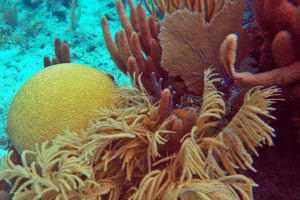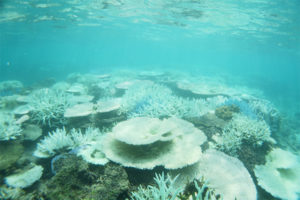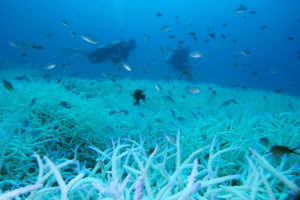Biologists’ Study Links Ocean Conditions and Coral Evolution
September 17, 2020A study conducted by Harvey Mudd College biologists provides evidence that ocean geochemistry drives patterns of morphological evolution in anthozoans (corals and sea anemones).

Chinchorro Reef in the Mexican Caribbean Sea.
Photo courtesy of David Paz-Garcia
Biology professor Catherine McFadden, Andrea Quattrini (formerly a postdoc researcher at HMC, now a research zoologist and curator of corals at the Smithsonian Institution) and Estefanía Rodríguez, a curator at the American Museum of Natural History, published the research in August in the journal Nature Ecology and Evolution. The scientists spent several years on the project, including time to develop a target-enrichment technique for genomic sequencing of anthozoan species.
“It took us about two years just to work out all of the kinks in the DNA sequencing protocol we developed,” says McFadden, Vivian and D. Kenneth Baker Professor of Life Sciences. “We didn’t get the sequence data that underlies this paper until early 2018, and the complicated and time-consuming bioinformatic analyses then took another two years.”

A highly bleached coral reef in the Pacific Ocean. Photo courtesy of James Reimer and Takuma Fujii
The researchers analyzed hundreds of anthozoan specimens from museum collections around the world, then aligned the molecular data with fossil evidence of anthozoan history. The result is a phylogeny showing that anthozoans have existed on Earth for 770 million years, long enough to experience massive shifts in climate, fluctuations in ocean chemistry and several mass extinctions. It also provides a framework for predicting how well stony corals and soft corals will fare under impending global warming and ocean acidification.
In short, stony corals (the hard-bodied corals that build the foundations of coral reefs) will likely continue to diminish under changing environmental conditions. However, the evolutionary history of Anthozoa suggests other groups (soft corals, anemones) will persist and diversify in their wake.
Several students in McFadden’s lab contributed to this research and related projects, including Alicia Pentico ’19, Justin Jiang ’23 (as a high school student!), Brooks Macdonald ’20, Johnson Hoang ’20, Natasha Floerke ’19, Katie Erickson ’19, Aaron Friend ’17 and Emily Petroni ’21.
“We have several other papers closely related to this one that we’re working on and hoping to publish later this year or early next year,” McFadden says.

Divers swimming over a bleached coral reef. Photo courtesy of James Reimer and Takuma Fujii
In 2019, McFadden received a new National Science Foundation grant, which supports soft coral research in her lab. “We will continue using the sequencing method that we developed for the Nature Ecology and Evolution paper to study the soft corals that live on Indo-Pacific coral reefs,” she says. “Andrea will help oversee the bioinformatic analyses for that project and will host undergraduate student interns to work on the project at the Smithsonian. Our primary goal is to determine how many species there actually are (we currently don’t know) and which ones are found where.”
